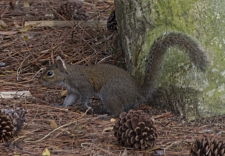Wildlife - Species

Eastern Gray Squirrel (Sciurus carolinensis)
Description
Characterized by gray fur and a bushy tail, the Eastern gray squirrel reaches a length of 41 to 51 cm (16 to 20 inches), half of which may be tail. Weight averages from 0.45 to 0.68 kg (1 to 1.5 pounds).
Preferred Habitat and Biology
The gray squirrel is common in hardwood forests with nut-producing trees. It can also be found in residential areas where it eats twigs, buds, seeds, and nuts. Cover is important for bedding, nesting and protection from predators. Tree cavities are used as dens for litter raising and winter shelter. Leaf nests consisting of leaves and twigs are also utilized by gray squirrels, although litter survival has been reported to be higher in cavities.
Population levels of gray squirrel are closely correlated with availability of hard mast. Diet generally includes twigs and buds, fruit, seeds and nuts which are often stored by burial for winter. Other supplemental food items include insects, bird eggs, frogs and lizards.
Mating takes place over two distinct breeding periods. The winter-spring period peaks in January, with young produced in February and early March. The spring-summer mating period peaks in June, with young produced in July. Sexual maturity and litter production generally occur between 10 months to 1 year of age. Gestation takes about 44 days, with the young generally remaining with the female for as long as 12 weeks.
Life expectancy of gray squirrels is short, averaging only 1-2 years. Population declines occur primarily as a result of mast crop failures. Because squirrel populations are resilient and can naturally recover in 1-3 years if food and weather conditions are favorable, hunting has little effect on population numbers. The natural mortality of gray squirrels is particularly high within the first year, and those young born in summer appear to have a higher mortality than those born in spring. Parasites such as fleas, botflies, and ticks are likely contributors to mortality. Major predators such as bobcats, raccoons, owls, hawks, and snakes probably do not limit populations.
Species Significance
Squirrels are primarily hunted recreationally in South Carolina, although there has been a dramatic decline in harvest of gray squirrels in recent years. Squirrel populations have not suffered any declines in population.
References
Baker, O.E., III and D.B. Carmichael, Jr. 1991. South Carolina's furbearers. South Carolina Department of Natural Resources, Columbia, SC.
Teaford, J.W. 1986. Eastern gray squirrel (Sciurus carolinensis). Section 4.7.1 U.S. Army Corps of Engineers Wildlife Resources Management Manual, Technical Report EL-86-6. U.S. Army Corps of Engineers Waterway Experiment Station, Vicksburg, MS
Webster, W.D., J.F. Parnell, and W.C. Biggs. 1985. Mammals of the Carolinas, Virginia, and Maryland. University of North Carolina Press, Chapel Hill, NC.
